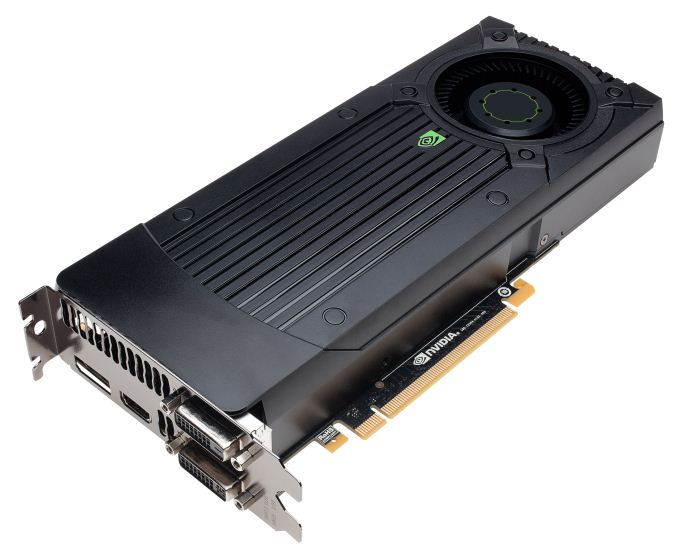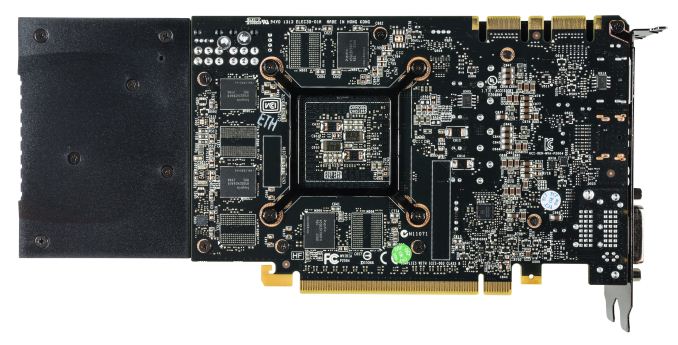NVIDIA GeForce GTX 760 Review: The New Enthusiast Kepler
by Ryan Smith on June 25, 2013 9:00 AM ESTMeet the GeForce GTX 760
As we mentioned earlier, due to its 170W TDP the GTX 760 is essentially a drop-in replacement for the GTX 670 in board designs. Even NVIDIA’s reference design reflects this, with the reference GTX 760 being based on the reference GTX 670’s cooler and PCB. Consequently there’s not much to say about the GTX 760’s design that we haven’t said before. If you’ve seen a GTX 670 then you’ve seen a GTX 760, down to the last screw. For consistency we’ll quickly go over the GTX 760’s design, but this is generally a rehash of what we’ve already said about the GTX 670.
Like GTX 670 before it, GTX 760 is another “small” GK104 design. The complete card is 9.5” long, however the actual PCB is far shorter at only 6.75” long, 3.75” shorter than the GTX 770’s PCB. In fact it would be fair to say that rather than strapping a cooler onto a card, NVIDIA strapped a card onto a cooler. Meanwhile we see that once again NVIDIA is using Hynix R0C (6GHz) GDDR5 RAM here.
The cooler itself is fairly simple, utilizing an aluminum heatsink melded with a copper base plate. A separate heatsink covers the VRM circuitry – once again mounted at the front of the card – while the fan hangs off of the rear of the card. This unfortunately is the same fan as on the GTX 670, which means it makes a faint grinding sound at low RPMs. This design has proven more than adequate for the GTX 670s, though it does leave some room for NVIDIA’s partners to improve on overall cooling performance, especially with open air coolers.
Elsewhere at the top of the card we’ll find the PCIe power sockets and SLI connectors. Two 6-pin PCIe sockets provide the necessary external power, while a pair of SLI bridge connectors at the other end allow for up to 3-way SLI. NVIDIA’s standard I/O configuration also makes an appearance here, offering 2x DL-DVI, 1x HDMI, 1x DisplayPort 1.2.
Looking at clockspeed bins for a moment, it comes as no great surprise that like the GTX 770, the GTX 760 operates at 1.2v at its highest stock clockspeed bin. The higher voltage versus the 1.76v limit on the 600 series causes power consumption to jump up more rapidly at the highest bins, but is necessary to unlock the 1100MHz+ clockspeeds the card is capable of.
| GeForce Clockspeed Bins | ||||
| Clockspeed | GTX 770 | GTX 760 | ||
| 1162MHz | N/A | 1.212v | ||
| 1149MHz | 1.212v | 1.2v | ||
| 1136MHz | 1.2v | 1.187v | ||
| 1123MHz | 1.187v | 1.162v | ||
| 1110MHz | 1.162v | 1.15v | ||
| 1097MHz | 1.15v | 1.137v | ||
| 1084MHz | 1.137v | 1.125v | ||
| 1071MHz | 1.125v | 1.112v | ||
| 1058MHz | 1.112v | 1.1v | ||
| 1045MHz | 1.1v | 1.087v | ||
Finaly, for overclockers there is one further bin (1162MHz) available via overvolting to 1.212v. The maximum power target meanwhile is 115%, for a final power limit of 195W.
















110 Comments
View All Comments
Spunjji - Tuesday, June 25, 2013 - link
Why would a faster card need to be cheaper? Shoo, shoo! Back under your bridge.UltraTech79 - Tuesday, July 2, 2013 - link
???vailr - Tuesday, June 25, 2013 - link
Will there be a "Small Form Factor" version, similar to:http://www.newegg.com/Product/Product.aspx?Item=N8...
chizow - Tuesday, June 25, 2013 - link
Sad day in the GPU industry when a part that's ~75% of the *SECOND* tier ASIC and sells for $250 can be considered "Enthusiast".It looks like Nvidia's marketing push to carve out ultra and uber enthusiast markets has worked, on the media anyways. Parts in this range used to be referred to as mainstream/midrange performance or gamer cards in the past, never once referred to as "Enthusiast".
Honestly if this $250 part is "Enthusiast" what are the $400 770, the $650 780, the $1000 Titan??? I guess we need to cough up $250 more for each Uber we place in front of Enthusiast; maybe at some point we just find new words and categories when one has been devalued and depreciated to the point it no longer holds any meaning.
Aside from the rant, the part's price and performance looks good. It's pretty clear at this point Kepler benefits more right now from the ROPs and bandwidth than SP and TMU. May change with future shader intensive titles, but the 760 pretty much confirms the 660Ti (and virtually any 30%+ bandwidth-neutered parts) was a big mistake.
thesavvymage - Tuesday, June 25, 2013 - link
who cares what ASIC it comes from, its irrelevant. Its a $250 gpu that performs as well or better than more expensive cards. Thats not mainstream, its enthusiast. Everything above it is enthusiast. The absolutely biggest amount of gpu sales come from those south of $200, so thats what most people consider mainstream.chizow - Wednesday, June 26, 2013 - link
People who don't enjoy getting less for the same price care what ASIC it comes from. I guess you don't mind getting smaller and smaller burgers, or less and less ounces in the food you buy at the grocery each year?There is nothing enthusiast about this product, it's mainstream performance in the same price and market bracket that litters all of Nvidia's previous marketing slides in this $200-$300 range. Was the 8800GT an enthusiast card? No. Was the 560Ti an enthusiast card? No. Yet they both satisfy the criteria you set forth.
teiglin - Tuesday, June 25, 2013 - link
I was just thinking about this after reading the review over at Tom's (they refer to the 760 as mainstream). It's an interesting sociological exercise, how different people view the term enthusiast. Given the massive stratification at the high end--I mean, Titan, ffs--what is the cutoff for being an "enthusiast" card? Why even bother with hyperbolic modifiers when nobody who spends even $400 on a GPU would do so without knowing the difference between a 770, a 780, and a Titan, not to mention the 7970 [GHz edition], 7950 [Boost], etc.?Personally, I'm inclined to agree with Ryan here. This is still a heckuva lot more graphics horsepower than, say, certain yet-to-be-released consoles, which I would argue define a "mainstream" baseline. Though if you're just commenting on how much the lowest common denominator in graphics performance has fallen, then that may be a sad day for the GPU industry, but it's a good day for consumers, who are able to get way more GPU for much less money than a couple years ago.
chizow - Wednesday, June 26, 2013 - link
Sorry but getting "way more GPU for much less money than a couple years ago" is just progress and should be expected.The context for how different people view the term enthusiast should be consistent, based on historical price and performance categories as well as physical and marketing segmentation factors. All of which indicate this is NOT an enthusiast part. Nvidia has clearly defined this in the past, and the enthusiast market did not start until $350+.
Some may say, "who cares", I guess people who actually shop in this $350+ market care, because calling a $250 part sets a terrible precedent, same as selling a tier-2 midrange ASIC like GK104 at $500 sets a terrible precedent. Why? Because if Nvidia is selling their 2nd fastest ASIC at "Enthusiast" price ranges starting at $250 all the way to $500, that gives them license to sell their actual Enthusiast parts at much more than $500.
Is it any surprise that we now have $650 GTX 780 and $1000 GTX Titan and GTX 690? Of course not. Why? Because people are doing cartwheels in the streets over the privilege of buying a stripped down, overclocked 2nd-tier ASIC for $250, because it's the new enthusiast part!
UltraTech79 - Tuesday, July 2, 2013 - link
I put the $1000 Tital as 'Rich retard soon parts with his money.' Also, shut the fuck up elitest dumbfuck. Anyone willing to spend $200+ on a GPU is an enthusiast and is looking for more than just enough.chizow - Friday, July 5, 2013 - link
Yes just like the guy who rices up his Civic is now driving a "luxury sports car". Just another idiot that doesn't understand I'm actually advocating against elitest pricing and marketing brackets, move along if you don't understand the concepts and repercussions.